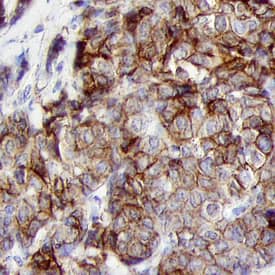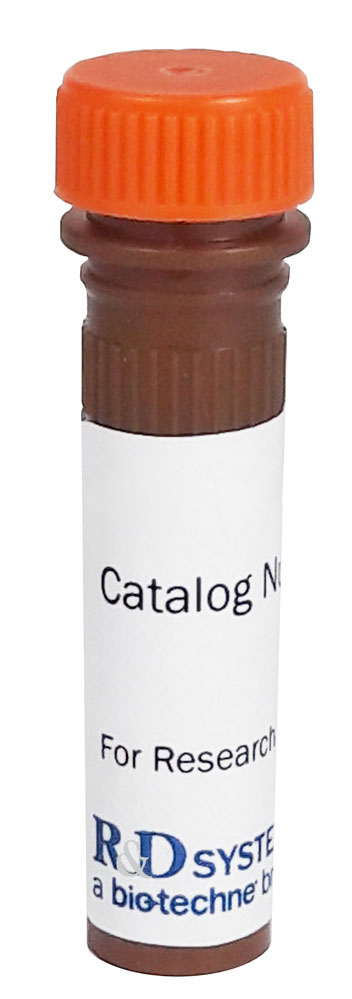Human CEACAM-5/CD66e Antibody
Human CEACAM-5/CD66e Antibody Summary
Lys35-Ala685
Accession # Q8N4D0
Customers also Viewed
Applications
Please Note: Optimal dilutions should be determined by each laboratory for each application. General Protocols are available in the Technical Information section on our website.
Scientific Data
 View Larger
View Larger
CEACAM‑5/CD66e in Human Breast Cancer Tissue. CEACAM‑5/CD66e was detected in immersion fixed paraffin-embedded sections of human breast cancer tissue using Sheep Anti-Human CEACAM‑5/CD66e Antigen Affinity-purified Polyclonal Antibody (Catalog # AF4128) at 10 µg/mL overnight at 4 °C. Before incubation with the primary antibody tissue was subjected to heat-induced epitope retrieval using Antigen Retrieval Reagent-Basic (Catalog # CTS013). Tissue was stained using the Anti-Sheep HRP-DAB Cell & Tissue Staining Kit (brown; Catalog # CTS019) and counterstained with hematoxylin (blue). Specific labeling was localized to the plasma membrane of epithelial cells. View our protocol for Chromogenic IHC Staining of Paraffin-embedded Tissue Sections.
Preparation and Storage
- 12 months from date of receipt, -20 to -70 °C as supplied.
- 1 month, 2 to 8 °C under sterile conditions after reconstitution.
- 6 months, -20 to -70 °C under sterile conditions after reconstitution.
Background: CEACAM-5/CD66e
CEACAM-5, also known as CEA and CD66e, belongs to the large family of CEACAM and pregnancy specific glycoproteins. CEACAM molecules are either transmembrane or GPI-linked, and are differentially expressed between species (1, 2). Orthologs of human CEACAM-5 have not been described in other species. CEACAM-5, which is expressed primarily by epithelial cells, consists of an N-terminal Ig-like V-set domain followed by six Ig-like C2-set domains and a GPI anchor (2‑4). CEACAM-5 is synthesized as a 180 kDa, variably glycosylated molecule of which approximately 60% is carbohydrate (5). CEACAM-5 functions as a calcium‑independent adhesion molecule through homophilic and heterophilic interactions with CEACAM-1 (6-8). CEACAM-5 is restricted to the apical face of intestinal epithelial cells in the adult but is more diffuse during embryonic development and in tumors (7). This is consistent with a role in the development and maintenance of epithelial architecture. CEACAM-5 is upregulated in a wide variety of human tumors and is a commonly used cancer marker (9). It promotes tumor cell migration, invasion, adhesion, and metastasis (10). It also contributes to tumor formation by maintaining cellular proliferation in the presence of differentiation stimuli, and by blocking apoptosis following loss of ECM anchorage (anoikis) (11, 12). The GPI anchoring of CEACAM-5 can be released by GPI-PLD, resulting in a soluble molecule that also promotes tumor metastasis (13). Cell surface expression of CEACAM-5 on tumor cells prevents the adhesion of CEACAM-1 expressing NK cells and provides protection from NK-mediated lysis (6). CEACAM-5 also binds a subset of Neisseria opacity proteins (Opa) and E. coli adhesion proteins (14-16). These interactions trigger clustering of the lipid raft-localized CEACAM-5 to sites of pathogen contact (15, 16).
- Zebhauser, R. et al. (2005) Genomics 86:566.
- Hammarstrom, S. (1999) Semin. Cancer Biol. 9:67.
- Schrewe H. et al. (1990) Mol. Cell. Biol. 10:2738.
- Hefta, S.A. et al. (1988) Proc. Natl. Acad. Sci. USA 85:4648.
- Garcia, M. et al. (1991) Cancer Res. 51:5679.
- Stern, N. et al. (2005) J. Immunol. 174:6692.
- Benchimol, S. et al. (1989) Cell 57:327.
- Zhou, H. et al. (1993) J. Cell Biol. 122:951.
- Goldenberg, D.M. et al. (1976) J. Natl. Cancer Inst. 57:11.
- Blumenthal, R.D. et al. (2005) Cancer Res. 65:8809.
- Screaton, R.A. et al. (1997) J. Cell Biol. 137:939.
- Ordonez, C. et al. (2000) Cancer Res. 60:3419.
- Yamamoto, Y. et al. (2005) Biochem. Biophys. Res. Commun. 333:223.
- Chen, T. et al. (1997) J. Exp. Med. 185:1557.
- Bos, M.P. et al. (1997) Infect. Immun. 65:2353.
- Berger, C.N. et al. (2004) Mol. Microbiol. 52:963.
Product Datasheets
Citation for Human CEACAM-5/CD66e Antibody
R&D Systems personnel manually curate a database that contains references using R&D Systems products. The data collected includes not only links to publications in PubMed, but also provides information about sample types, species, and experimental conditions.
1 Citation: Showing 1 - 1
-
The CEA/CD3-bispecific antibody MEDI-565 (MT111) binds a nonlinear epitope in the full-length but not a short splice variant of CEA.
Authors: Peng L, Oberst MD, Huang J, Brohawn P, Morehouse C, Lekstrom K, Baeuerle PA, Wu H, Yao Y, Coats SR, Dall'Acqua W, Damschroder M, Hammond SA
PLoS ONE, 2012-05-04;7(5):e36412.
Species: Human
Sample Types: Whole Cells
Applications: Flow Cytometry
FAQs
No product specific FAQs exist for this product, however you may
View all Antibody FAQsReviews for Human CEACAM-5/CD66e Antibody
There are currently no reviews for this product. Be the first to review Human CEACAM-5/CD66e Antibody and earn rewards!
Have you used Human CEACAM-5/CD66e Antibody?
Submit a review and receive an Amazon gift card.
$25/€18/£15/$25CAN/¥75 Yuan/¥2500 Yen for a review with an image
$10/€7/£6/$10 CAD/¥70 Yuan/¥1110 Yen for a review without an image


